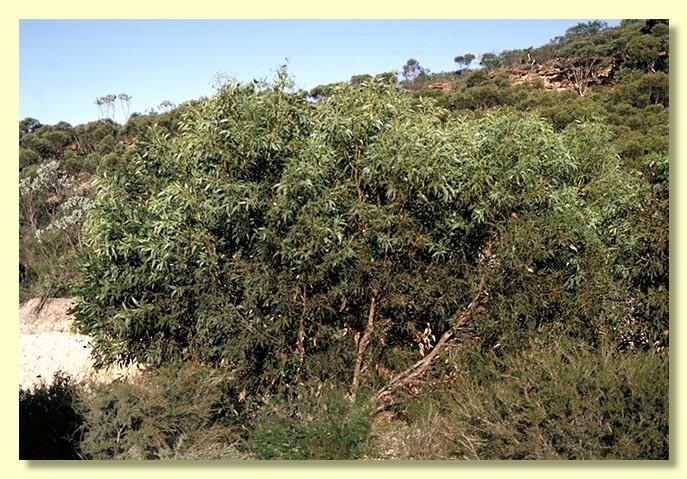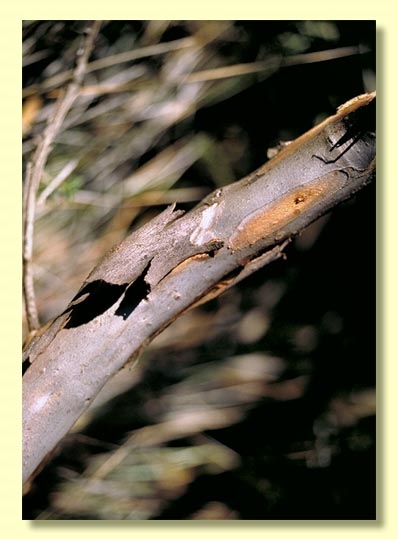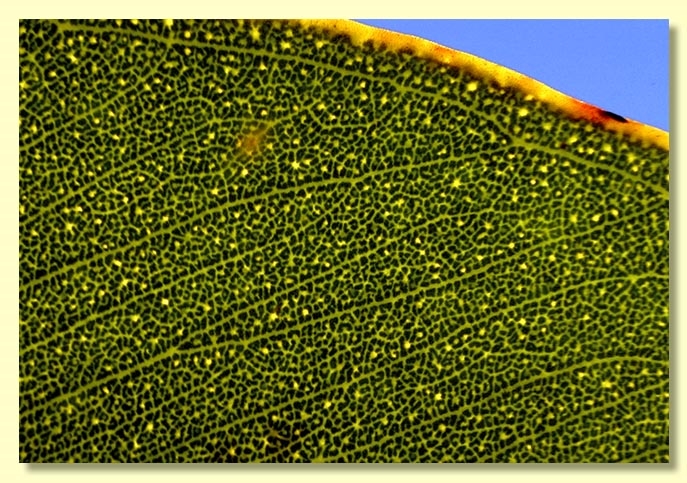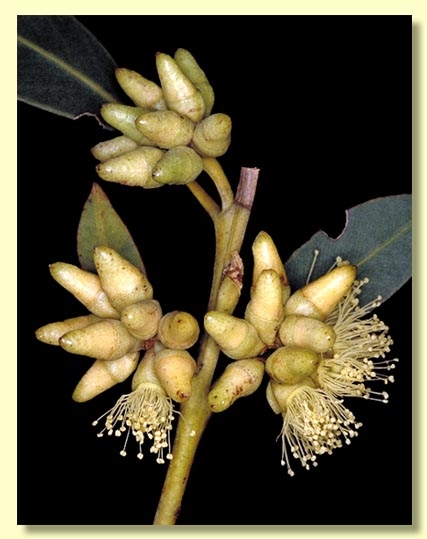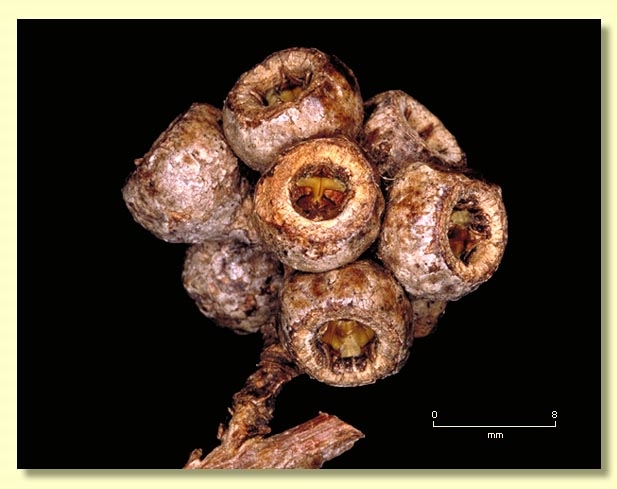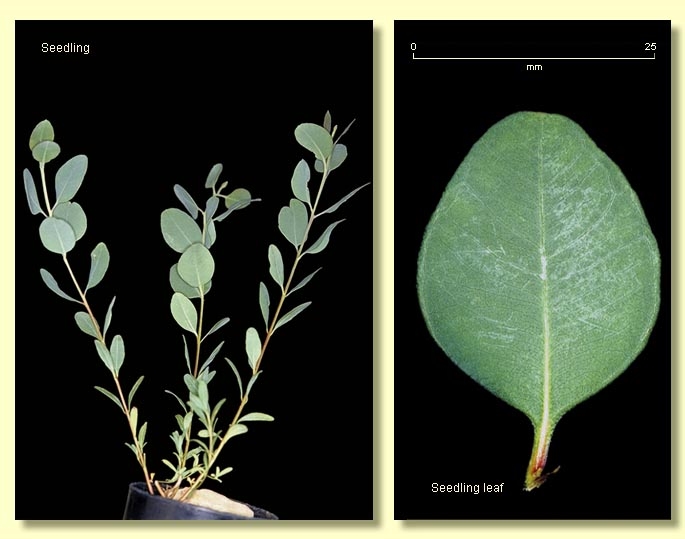Eucalyptus | Symphyomyrtus | Bisectae | Destitutae | Falcatae | Rugatae
Euclid - Online edition
Eucalyptus notactites
Eucalyptus goniantha subsp. notactites L.A.S.Johnson & K.D.Hill, Telopea 4: 610 (1992). T: Western Australia: Mt Melville garbage tip, 16.5 km from highway, 12 Nov. 1986, K.D.Hill 2429, L.A.S.Johnson, D.F.Blaxell & M.I.H.Brooker; holo: NSW; iso: PERTH.
Bark smooth throughout, pale grey to grey-brown over pink-orange.
Branchlets sometimes glaucous, always square in cross-section and sometimes winged; lacking oil glands in the pith.
Juvenile stems square in cross-section and sometimes winged, occasionally glaucous; juvenile leaves always petiolate, opposite for ca 10 nodes then alternate, orbicular to broadly ovate, 3–12 cm long, 2.5–11 cm wide, base truncate to rounded or tapering, apex usually rounded to emarginate, sometimes pointed, dull grey-green.
Adult leaves alternate, petioles 1.3–3 cm long; blade lanceolate, 7.5–15 cm long, 1.5–4 cm wide, base tapering to petiole, margin entire, apex acute, concolorous, dull to slightly glossy, green to grey-green, side-veins greater than 45° to midrib, reticulation very dense, intramarginal vein fairly close to margin, oil glands scattered, irregular, intersectional.
Inflorescence axillary unbranched, peduncles flattened, 0.5–1.5 cm long, buds 11 to 19 per umbel, sessile to shortly pedicellate (pedicels 0-0.2 cm long). Mature buds elongated ovoid (1–1.3 cm long, 0.5–0.6 cm wide), creamy white, scar present (outer operculum shed early), operculum smooth, conical to beaked (1 to 1.5 times length of hypanthium), hypanthium weakly angled rather than ribbed, stamens inflexed, anthers cuboid, versatile, sub-basifixed, dehiscing by longitudinal slits, style long and straight, stigma blunt to slightly rounded, locules (3)4, the placentae each with 4 vertical rows of ovules. Flowers creamy white.
Fruit sessile or very shortly pedicellate (pedicel 0-0.2 cm long), truncate-globose to hemispherical, weakly angled/ribbed or smooth, 0.5–0.8 cm long, 0.7–1.2 cm wide, rim thick, disc usually descending, valves (3)4, exserted but fragile.
Seeds grey-brown, 1–2.5 mm long, ovoid or flattened-ovoid, dorsal surface very shallowly reticulate, hilum ventral.
Cultivated seedlings (measured at node 10): cotyledons Y-shaped (bisected); stems square in cross-section, glaucous or not; leaves subsessile and elliptical to oblong at lower nodes becoming shortly petiolate, ovate to orbicular, alternate after 8 to 12 nodes, 3–5 cm long, 2.4–3.5 cm wide, dull, grey-green.
Flowering has been recorded in January, May, November and December.
A species of mallee endemic to Western Australia, of disjunct distribution in southern coastal areas from Albany east to Manypeaks, Cheyne Beach, Fitzgerald River National Park and east of Esperance including Recherche Archipelago; in usually dense mallee scrub on sandy loam. The bark is smooth or with loose rough bark near the base of the stems, branchlets strongly angled, adult leaves glossy green, and with sessile almost smooth buds in erect umbels of 11 to 19.
In the classification of Brooker (2000) the recently revised species Eucalyptus notactites belongs in Eucalyptus subgenus Symphyomyrtus section Bisectae subsection Destitutae because buds have two opercula, cotyledons are Y-shaped and branchlets lack oil glands in the pith. Within this subsection E. notactites belongs to a group of mallet and mallee species characterised by often pendulous inflorescences with often pedicellate ovoid buds with a conical to beaked operculum, flattened-globose fruits with exserted fragile valves and adult leaves that are green, densely reticulate and have numerous intersectional oil glands and smooth bark. The species are the mallets E. falcata, E. ornata, E. purpurata, E. recta, E. rugulata and E. annettae; and the mallees E. dorrienii, E. petrensis, E. ecostata and the newly described E. opimiflora, plus the coastal and sub-coastal mallees E. goniantha (with two subspecies), E. kessellii (with two subspecies), E. notactites and E. semiglobosa. These mallets and mallees together form series Falcatae subseries Rugatae, albeit in a form somewhat modified from Brooker's classification.
Of the mallee species in subseries Rugatae, E. notactites is most likely to be confused with E. goniantha but lacks the pedicels and ribbing on the buds and fruit of that species. Also E. goniantha never has winged glaucous branchlets, and does not occur any further east than Manypeaks. E. kessellii differs in its umbels of diamond-shaped buds in 3s or 7s on downturned peduncles, having visibly ribbed opercula. All three species differ from the other malles in subseries Rugatae in having flattened peduncles.
The mallet species in subseries Rugatae, viz. E. falcata, E. purpurata, E. rugulata, E. recta, and E. ornata are all tall smooth-barked non-lignotuberous trees from the wheatbelt or nearby, and are easily distinguished from E. notactites by the growth habit and finely tapering conical opercula. The newly described mallet from near Israelite Bay, E. annettae, has squared and often glaucous branchlets but has prominently ribbed buds and fruit.

